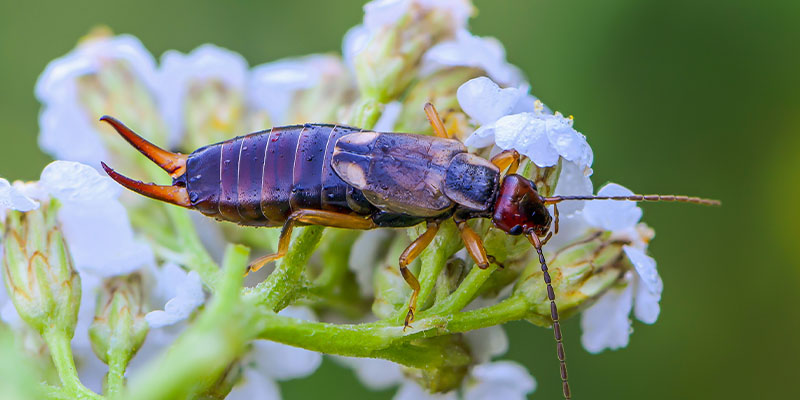Pincher bugs, commonly known as earwigs, have long intrigued homeowners due to their distinctive pincers and secretive behavior. So, because of their mysteriousness, we’ll delve into the world of pincher bugs, shedding light on their characteristics, behaviors, and potential impact on households. We’ll also explore their attraction to specific environments, reproduction rates, the purpose of their pincers, any damage they might cause, health risks they pose, and effective strategies for preventing and managing their presence.
What is a Pincher Bug Anyway
A pincher bug, also known as an earwig, is a small insect that is about 1 to 1.5 inches long. They have long, thin bodies and six legs. The most distinguishing physical feature of the earwig is the claw-like forceps (or cerci) located on the end of the abdomen. These forceps are straight-sided on most females but are more pincer-like on males. Earwigs use their forceps mainly as defensive weapons, but they also use them to capture prey.
Why Are Pincher Bugs Also Known as Earwigs?
The name “earwig” comes from the superstition that these insects crawl into people’s ears and bore right into their brains. Of course, this is not true, but earwigs are sometimes attracted to dark, moist places, such as ears. However, this claim is largely unfounded. The nickname likely originates from their distinctive pincers, which do seem to resemble the shape of an ear.
Pincher Bug Characteristics and Behavior
Pincher bugs, scientifically known as Dermaptera, are characterized by their elongated bodies, pincers, and flexible antennae. These nocturnal insects are often dark brown in color and range in size from 5 to 25 millimeters. These forceps are straight-sided on most females but are more pincer-like on males. They can fly, but they do not do so often. Pincher bugs are omnivorous, which means they eat both plants and animals. Their bite is not poisonous, but it can be painful.
Attraction and Reproduction
Pincher bugs are commonly found in damp, dark environments, such as under leaves, rocks, logs, and mulch. They are attracted to areas with moisture, decaying matter, and shelter. They are often found in gardens, under rocks and debris, and in damp basements and crawlspaces. They are also attracted to food sources, such as fruits, vegetables, and decaying organic matter.
Pincher bugs can multiply quickly. Females can lay up to 50 eggs at a time, and the eggs hatch in about two weeks. The young earwigs mature in about two months. So, they can quickly produce a large population and this may become the source of one or more problems for homeowners.
What’s Pincer Function Anyway?
The pincers, or cerci, at the rear of the pincher bug’s body serve various purposes. They are primarily used for defense, capturing prey, interacting with other members of their species, and digging burrows. The pincers can also be used to grasp objects, such as food. All and all, they are utilitarian and not really a source of danger to humans and pets.
Damage Potential
Pincher bugs can cause some damage to gardens and homes. They can chew on leaves, flowers, and fruits. They can also burrow into wood and fabrics. However, they are not considered to be major pests. While pincher bugs primarily feed on decaying organic matter and small insects, they can occasionally cause damage to plants, fruits, and flowers. Although, their impact on gardens is generally minimal.
Health Risks
Pincher bugs are not considered harmful to humans. Despite the myth of crawling into ears, they do not pose a significant health risk. Their pincers are too weak to cause any real harm. They are not known to carry diseases, and their bites are not poisonous. Still, their pincers can pinch, and some people may be allergic to their bites.
Prevention and Management
There are a few ways to get rid of pincher bugs. One way is to eliminate their food sources and nesting sites. This can be done by removing debris and keeping your home and garden clean. You can also try using insecticidal soap or neem oil. If the infestation is severe, you may need to call a pest control professional. Meanwhile, here are some additional tips for preventing pincher bugs:
- Seal up any cracks or holes in your home’s foundation or exterior.
- Keep your yard free of debris and weeds.
- Aerate your lawn regularly to improve drainage.
- Do not over-water your lawn.
You can also plant flowers that attract beneficial insects, such as ladybugs, which prey on pincher bugs. Before you do, be sure to conduct a little due diligence and research which species are most beneficial, are native to the area, and don’t attract other destructive pests.
What We’ve Learned
Pincher bugs, or earwigs, may appear mysterious and even intimidating due to their pincers, but they are generally harmless insects. Their attraction to damp environments and decaying matter serves ecological roles in breaking down organic material. While they might cause minimal damage to plants, they do not pose health risks to humans.
Homeowners can manage pincher bug populations through proactive measures like reducing moisture, maintaining gardens, and sealing entry points. With a better understanding of their behavior and ecological role, pincher bugs can coexist with peacefully in our outdoor spaces.

